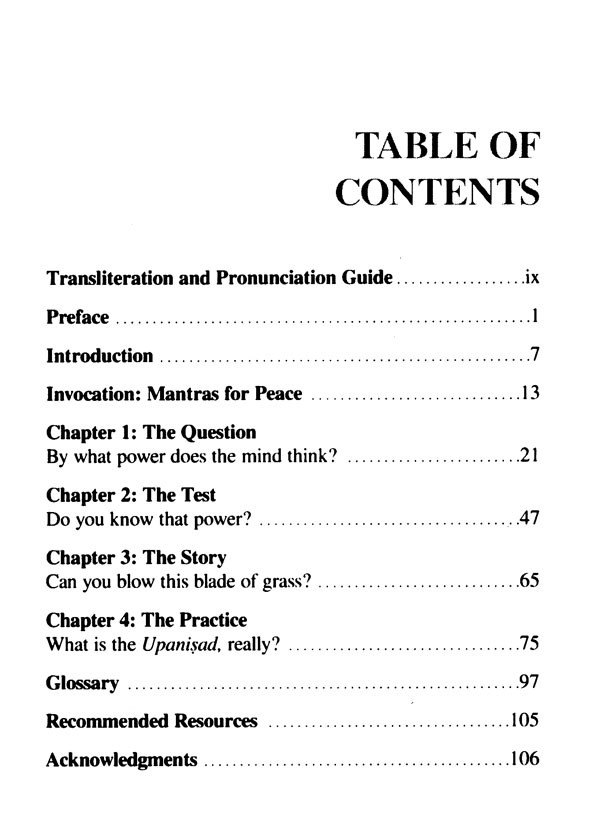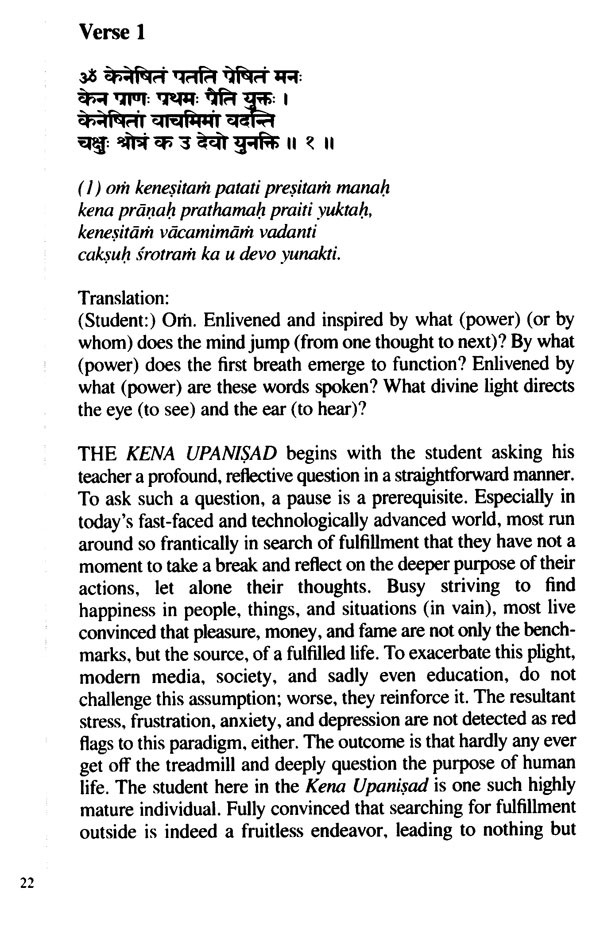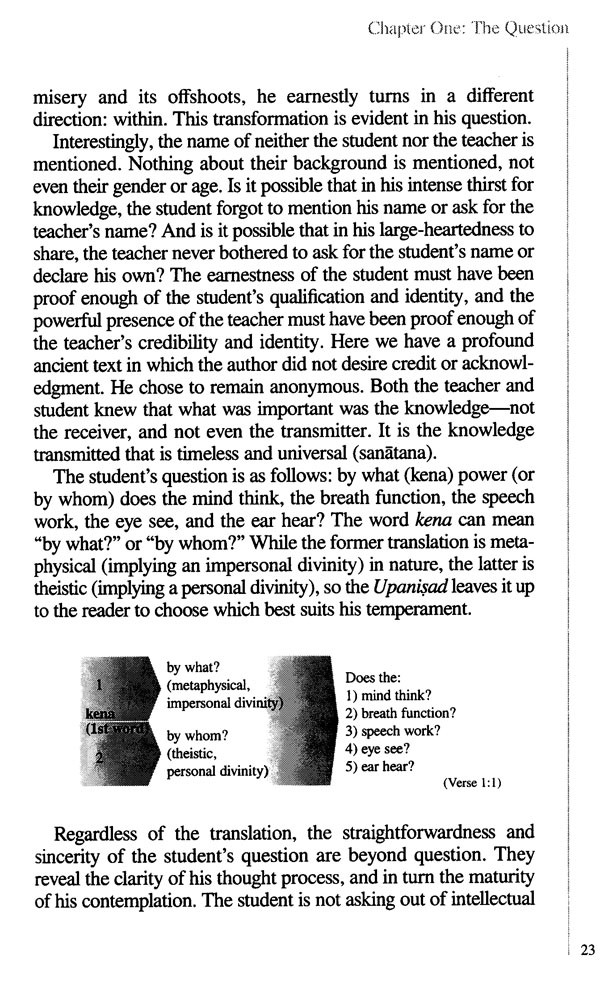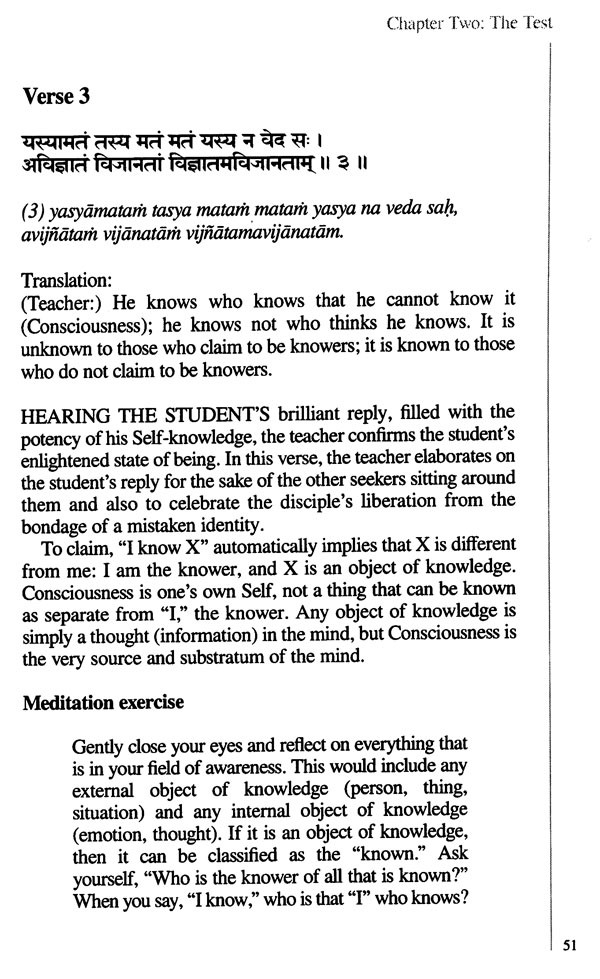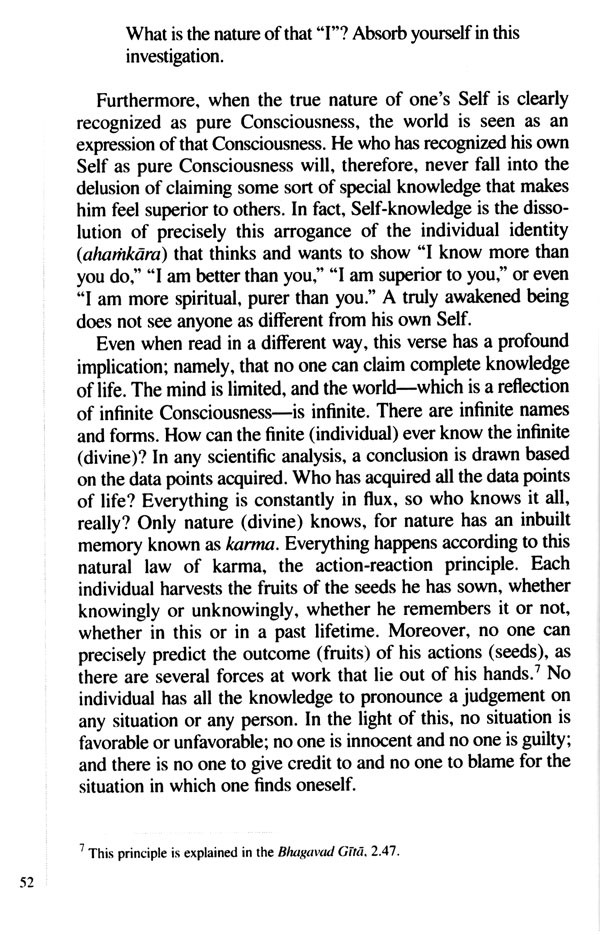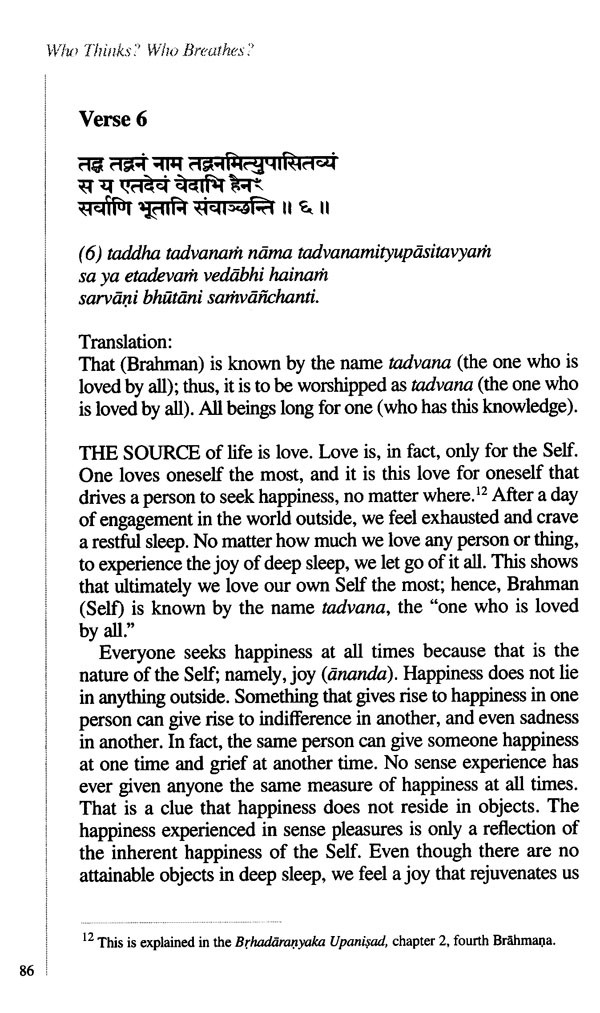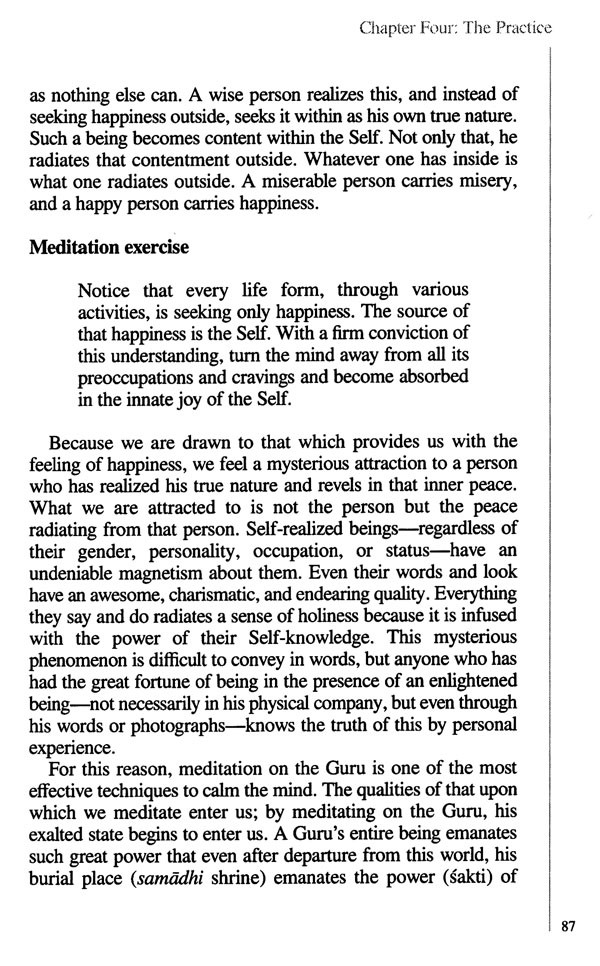
Who Thinks? Who Breathes? (Reflections on The Kena Upanishad
Book Specification
| Item Code: | NBZ035 |
| Author: | Vivek Desai |
| Publisher: | SHANTI MANDIR |
| Language: | SANSKRIT TEXT WITH TRANSLITERA |
| Edition: | 2018 |
| ISBN: | 9781732142039 |
| Pages: | 109 |
| Cover: | PAPERBACK |
| Other Details | 8.00 X 5.00 inch |
| Weight | 140 gm |
Book Description
What sets humans apart from animals? Undoubtedly, it is the intellect's ability to reflect on life, death, and beyond. Only we can ask: "What power gives life to my body?" The Kena Upanishad is a sacred text that deeply explores this existential question. With his unusual background combining a rigorous education in science and a committed practice of yoga wisdom, Vivek Desai brings to light the relevance and practical application of this ancient scripture, making it accessible to the modern reader without compromising its sublimity.The focus of this translation and reflective commentary is on guiding readers to find fulfillment in their lives.
In Who Thinks? Who Breathes? Reflections on the Kena Upanishad...
- An accessible English translation
- Lucid reflections, relevant to modern life
- Pragmatic interpretations of sublime revelations
- Simple diagrams to help understand esoteric concepts
- Short but powerful meditations to give a firsthand experience of our true nature
THIS BOOK is not a traditional commentary on the Kena Upanisad-a sacred text on nonduality(advaita)-but might be better described as a compilation of my reflections on it.
The Sanskrit word kena means "by what?" or "by whom?" Essentially, it is interrogative in nature. This word deeply resonated with me because the spirit of questioning has always been natural to me. It was for this reason that I chose to pursue a degree in science. I was blessed to have excellent teachers train me in scientific method and research. I even went on to pursue a graduate degree in molecular biology. But I hit a brick wall-not externally, but internally. A deep conviction arose in me, triggered by a calling to wholeheartedly pursue the path of self-inquiry, that science is incapable of answering all questions in life. This was not disenchantment with science per se, but simply the realization of its limitations. For science-or any external pursuit, for that matter-cannot answer the existential question "What is the means to live a fulfilled life?
Indeed, this inner quest had creeped in tangibly since the first year of my undergraduate college days. While I was pursuing science, I had a parallel pursuit in philosophy (first Western and then Indian), which soon expanded to include the practice of meditation. What triggered that expansion? The awakening is still fresh in my mind and heart.
It happened before beginning my second year as an undergraduate student. As an avid reader seeking the meaning of life, I had already turned to the sacred texts of the yoga tradition. Raised by a mother who is an ardent devotee of Baba Muktananda, the Guru of Gurus who created a "meditation revolution" in the 1970s and early 1980s, I was supremely blessed to grow up in an atmosphere of devotional love. However, obviously until a personal connection is made, one's worship remains distant and foreign. Having noticed my sincere seeking, my mother recommended I read Baba Muktananda's spiritual autobiography, Play of Consciousness. And I casually thought, "Why not?" Little did I know then that my life would never be the same again. The person who finished reading that book was not the same as the one who started it. Baba Muktananda's words penetrated my being so deeply that it felt like taking a bath in the holiest of holy rivers. His worship of his Guru, the great avadhuta Bhagavan Nityananda of Ganeshpuri, touched a part of me that was so deep I did not even know existed. I didn't want the book to ever finish. I felt Baba was talking directly to me. I felt accepted, loved. I felt love that cannot be described in words. I felt complete. Tears welled up. There was nothing lacking in that experience. And most surprisingly, it felt so natural, nothing new or foreign. Baba's look and words ignited a deep longing within me to live in the state he lived in. I had never seen anyone like him-full of joy, totally free of any misery. I felt as if I were looking in a mirror, seeing what I can be and what I really am.
That heartfelt and visceral experience changed my life beyond what I could have imagined. What I had previously thought important dropped away. And things continue to drop away as I continue to unwrap that divine gift. I knew deep inside that Baba had answers to all the questions I was asking. I knew the path of meditation he pursued and so generously shared with the world is the means to find answers to the questions science, technology, and all external discoveries cannot answer. I knew the path of meditation alone could give the experience of fulfillment, not momentary sense pleasures or achievements.
The practice of meditation leads to an inquiry into one's true identity in order to find eternal happiness. This process is known as self-inquiry (atma-vicara). Because the word kena pointed to this profound secret, I could not help but enthusiastically embark on a deep exploration of this text in November 2016. Watching eloquent and lively lectures by Swami Chinmayananda, one of the great masters of the twentieth century, on this text further inspired me. I reveled in each word of this scripture, and found that each verse serves as a powerful pointer capable of catapulting the student into that state of wholeness or nonduality that is of the nature of peace, peace, and nothing but peace. It seemed too good not to share with others.
A series of opportunities allowed me to share the wisdom of the Kena Upanisad in public settings. First, I led an evening workshop at Hindu Temple of Delaware, and then led a month-long workshop series at Vitality Yoga in New Paltz, NY, both in the spring of 2017. These sharings allowed me to better formulate my reflections, which in turn deepened my understanding and experience of the scripture. The feedback-gauged not just by the verbal appreciation of the participants but also by the deep meditative silence palpable in the room-was so uplifting that penning my reflections and sharing them with a wider audience seemed the next natural step. The result of that is currently in your hands.
Due to the organic creation of this work, it should not be viewed as a commentary for academic study. Its purpose is not to satisfy intellectual curiosity but to inspire an experience of that divine supreme principle whose nature is eternal peace. I suggest pausing after each verse and reflecting on the impact of what has been shared. Many verses are followed by meditation exercises to engender a direct experience of the revelations. Given an opening, this timeless wisdom can completely transform our lives.
I pray to the Guru that this work may inspire every reader to inquire into his or her true nature and find peace within.
ANIMALS BUILD neither crematoriums nor houses of worship, which shows that they cannot reflect deeply on the nature of life, death, and beyond. What sets human apart from the rest of the animal kingdom? We carry out all the functions that most animals do: eating, sleeping, excreting, reproducing, and competing. But there is one unique human faculty that distinguishes us from them: the intellect (buddhi, or viveka, the power of discernment). The intellect allows us to reflect, to question, to inquire.
The scientific and the technological progress we have made, and even the very birth of civilization, owes its existence to this unique faculty of the intellect. To inquire about the external world enables progress in science, technology, art, politics, commerce, and trade. While advancement in the outer world certainly makes our lives comfortable, it does not provide contentment to the mind. Examples abound of personalities who have achieved tremendous success and fame in their respective fields, and even helped the world with their ingenious work, yet their personal lives remained plagued with stress and frustration, and in extreme cases, with anxiety and depression. Given this, what is the key to a satisfying life?
The wise beings of ancient India reflected deeply on this human condition, and discovered thousands of years ago that progress in the outer world is incomplete without an exploration of the inner world. The same intellect that allows us to explore the outer realms is capable of exploring the inner realms. While to investigate without is known as science, to do the same within is known as self-inquiry (atma-vicara, or mananam, reflection).
This time-tested practice can enable one to discover peace within oneself, allowing one to overcome inner turmoil and unlock enormous hidden potential. The Upanisads are conversations of self-inquiry in the ancient oral tradition between enlightened masters and sincere seekers, in which the nature of true identity is explored.
The Upanisads constitute the foundational sacred literature of Vedanta, one of the many living philosophical traditions of India. These sacred texts are thousands of years old. The date of their origin is subject to debate and can never truly be determined, for this wisdom was orally transmitted (sruti, that which is heard) from teacher to student before it was finally written down for posterity. Furthermore, its classification as sruti also shows that this wisdom was revealed to the sages (rsi) in deep meditative states; thus, these texts are not products of any human mind but point to the eternal wisdom of nature that can be experienced by anyone at any time when the mind becomes silent. The ancients, therefore, did not bother to record the dates of these texts; for them, it was the wisdom contained therein that was important, not the date of writing, and not even the identity of the writer. The date of their origin might be ancient, but their wisdom is for all ages; the place of their origin might be the Indian subcontinent, but their wisdom is for all of humanity. Hence, this wisdom is known as sanatana-timeless and universal.
Adi Sankaracarya, the great sage-philosopher who lived around the eighth century CE, explains the word upanisad as made up of three words': upa, which means "near"; ni, which means "steadfastness"; and sad, which has three meanings: "loosening of the ties," "propulsion (or knowledge)," and "complete destruction of all shackles." Thus, upanisad means the ultimate knowledge obtained by approaching (upa) an enlightened master with sincerity (ni); imbibing this knowledge provides an immediate sense of relief, and finally propels us to realization of our true nature, which destroys all attachments (sad), the root of suffering. Upanisad is thus also the title given to a sacred text that explores this ultimate knowledge, the knowledge of our true nature.
The Upanisads are classified as belonging specifically to the school of Advaita Vedanta, the nondual school within the philosophical tradition of Vedanta. Advaita means "not two [entities]," and Vedanta refers to the wisdom found at the "end portion (anta) of the Vedas . The word vedanta can also be translated as the "end (anta) of all knowledge (veda)," meaning there is nothing higher than this knowledge of nonduality (advaita). Any other knowledge, any other information, in any field, is incomplete. In other words, a sense of complete fulfillment is experienced only when the wisdom of non-difference between oneself and the other dawns. This is not just the subject of all the Upanisads but is the true import of the word upanisad.
There are hundreds of Upanisads, and even though sadly many might have been lost (or may be even destroyed) over time, we fortunately still have enough available to guide us in our quest for eternal happiness. The Kena Upanisad, found in the Sama Veda, is one such Upanisad, classified as one of the ten principal Upanisads, and the only one on which Adi Sankaracarya wrote two commentaries. The title Kena Upanisad comes from the first word of the text: kena (by what? by whom?). The straightfor-wardness of this Upanisad is extraordinary. Its clarity is laser sharp. And its structure is enchanting, with the most notable feature being that both poetry (chapters one and two) and prose (chapters three and four) are included. Interestingly, lines are not drawn between personal and impersonal divinity.
This text provides a more effective approach than do psychiatry or psychotherapy for achieving mental balance. The divine is constantly pointed at but never described, and the key to interfaith harmony is given. The teacher tests the student by asking a question and tells a captivating story about gods and demons. The Goddess is invoked; nature meditations are explored; spiritual practice is visualized as a temple structure; practical tips for embodying the loftiest principles are offered; and most importantly, the message of nonduality is delivered without any compromise.
Come, join us as we listen in on this sublime conversation between an earnest seeker and a powerful Guru, in the hope that we, too, may unfold our human potential; discover true happiness; and live our lives more authentically, efficiently, and in harmony with everyone and everything around us.
**Contents and Sample Pages**
